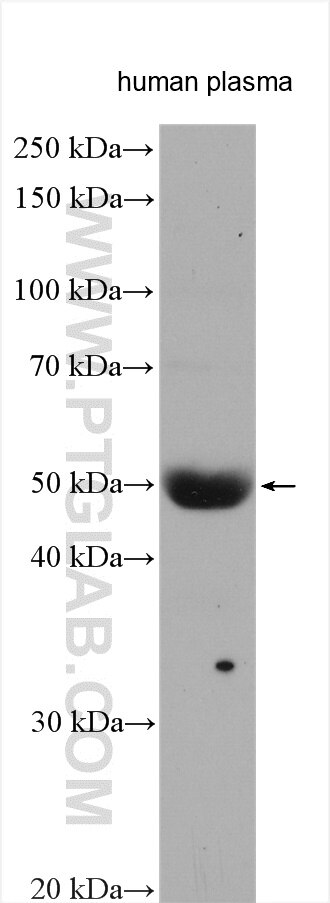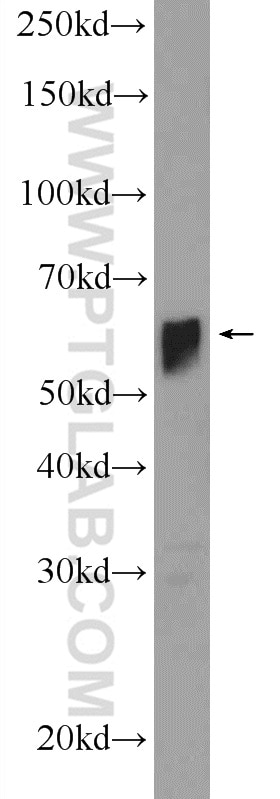Tested Applications
| Positive WB detected in | human plasma tissue |
Recommended dilution
| Application | Dilution |
|---|---|
| Western Blot (WB) | WB : 1:500-1:2000 |
| It is recommended that this reagent should be titrated in each testing system to obtain optimal results. | |
| Sample-dependent, Check data in validation data gallery. | |
Published Applications
| WB | See 1 publications below |
Product Information
12741-1-AP targets SERPIND1 in WB, ELISA applications and shows reactivity with human, mouse, rat samples.
| Tested Reactivity | human, mouse, rat |
| Cited Reactivity | human |
| Host / Isotype | Rabbit / IgG |
| Class | Polyclonal |
| Type | Antibody |
| Immunogen |
CatNo: Ag3637 Product name: Recombinant human SERPIND1 protein Source: e coli.-derived, T-HIS Tag: 6*His Domain: 149-499 aa of BC035028 Sequence: DNIFIAPVGISTAMGMISLGLKGETHEQVHSILHFKDFVNASSKYEITTIHNLFRKLTHRLFRRNFGYTLRSVNDLYIQKQFPILLDFKTKVREYYFAEAQIADFSDPAFISKTNNHIMKLTKGLIKDALENIDPATQMMILNCIYFKGSWVNKFPVEMTHNHNFRLNEREVVKVSMMQTKGNFLAANDQELDCDILQLEYVGGISMLIVVPHKMSGMKTLEAQLTPGVVERWQKSMTNRTREVLLPKFKLEKNYNLVESLKLMGIRMLFDKNGNMAGISDQRIAIDLFKHQGTITVNEEGTQATTVTTVGFMPLSTQVRFTVDRPFLFLIYEHRTSCLLFMGRVANPSRS Predict reactive species |
| Full Name | serpin peptidase inhibitor, clade D (heparin cofactor), member 1 |
| Calculated Molecular Weight | 499 aa, 57 kDa |
| Observed Molecular Weight | 57-60 kDa |
| GenBank Accession Number | BC035028 |
| Gene Symbol | SERPIND1 |
| Gene ID (NCBI) | 3053 |
| RRID | AB_2877878 |
| Conjugate | Unconjugated |
| Form | Liquid |
| Purification Method | Antigen affinity purification |
| UNIPROT ID | P05546 |
| Storage Buffer | PBS with 0.02% sodium azide and 50% glycerol, pH 7.3. |
| Storage Conditions | Store at -20°C. Stable for one year after shipment. Aliquoting is unnecessary for -20oC storage. 20ul sizes contain 0.1% BSA. |
Protocols
| Product Specific Protocols | |
|---|---|
| WB protocol for SERPIND1 antibody 12741-1-AP | Download protocol |
| Standard Protocols | |
|---|---|
| Click here to view our Standard Protocols |
Publications
| Species | Application | Title |
|---|---|---|
Sci Rep Association of urinary ketamine and APOA1 levels with bladder dysfunction in ketamine abusers revealed via proteomics and targeted metabolite analyses. | ||
Oncol Rep Analysis of the gene expression profile in response to human epididymis protein 4 in epithelial ovarian cancer cells. |






